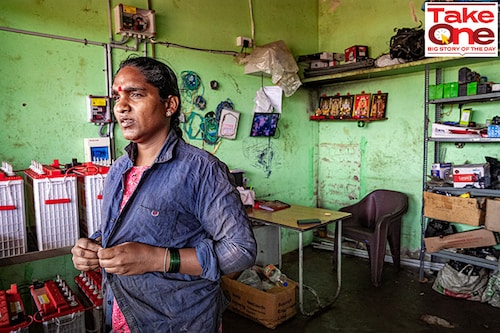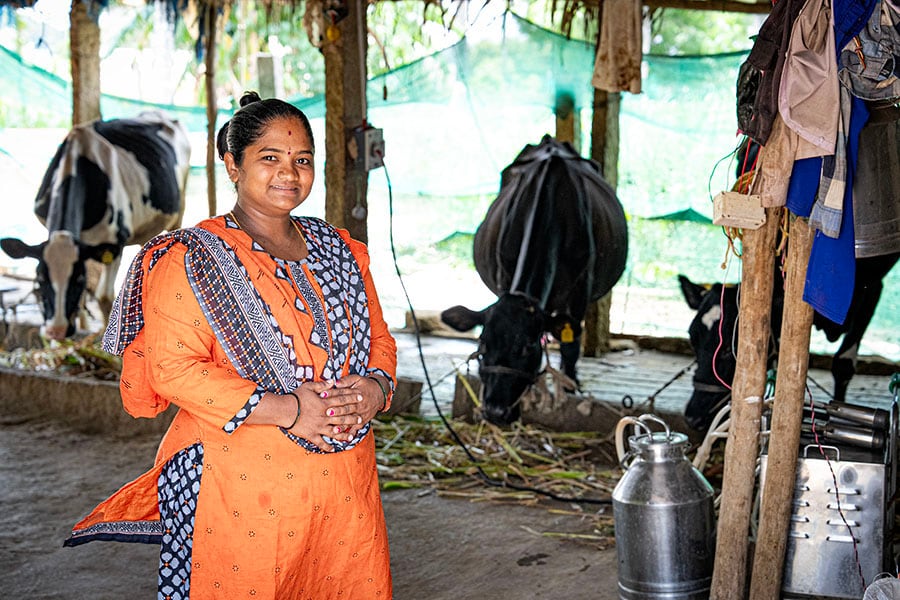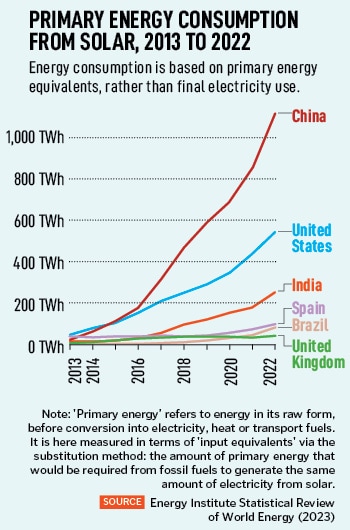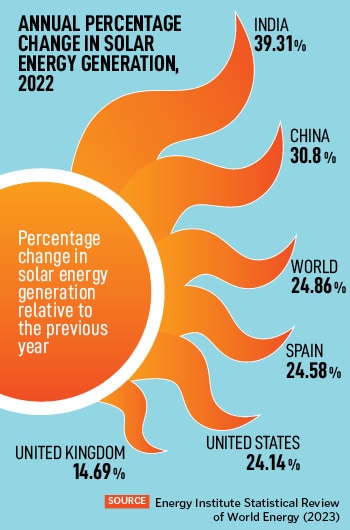How India's solar push is empowering women
From garages to papad-making machines, solar-powered technologies are providing women with home-based micro-entrepreneurship opportunities, increasing their productivity and reducing drudgery


About 40 km away from Bengaluru, in Devanahalli, by the highway in an auto repair shop Om Shakti Garage, men in blue overcoats bustle around, as people come and go. As we approach closer, a woman dressed in a bright pink kurta, who has been working on her finances in a notebook, stands up from the desk in the corner and greets us with a warm smile: “Namaste, mera naam Yallama hai. Mein transgender hoon [Namaste, my name is Yallama. I am a transgender woman]." Born in Raichur in Karnataka, Yallama was thrown out of her house as a five-year-old, and ended up living on the streets, with begging her only source of income. “All I wanted was some respect," she tells us. She made her way to Bengaluru, where she decided to start learning at a mechanic’s shop, pretending to be a man. Eventually, with the Rs 10,000 she had saved up, she bought some tools and set up a small mechanic’s shop by the road. Two years ago, she managed to rent a space in Devanahalli for ‘Om Shakti Garage’.
Around the same time, she came across the work that Selco Foundation has been doing. “I requested them to help me set up a garage," she adds. “We only get three hours of electricity in a day, and I need constant electricity for a functioning garage." Selco has helped her set up a fully solar-powered garage. “With the machines that Selco has helped me get, our work happens faster. Instead of working on one or two two-wheelers in a day, we now work on five to eight in a day," she says. She has also hired five workers in her team and is now earning Rs 12,000 per month (after deducting Rs 8,000 for rent) from her garage.
Yallama is only one of the many women with an entrepreneurial zeal that solar-powered technologies have helped to earn a livelihood for themselves.
India aims to achieve 500 GW of electricity generation capacity through non-fossil sources by 2030. In achieving this, solar power is playing a massive role—as per reports of the Central Electricity Authority, the renewable energy capacity has almost doubled in the last five years (at 131 GW as of July 2023), with solar capacities trebling. This push for solar- powered solutions is also encouraging women—who are both invisible and industrious—to become more economically empowered.
Currently, solar capacity stands at ~71 GW, forming 54 percent of the total renewable energy capacity (up from 32 percent share in July 2018). In FY23, India added ~15 GW of RE capacity. Of this, 12.7 GW was from solar. “While utility-scale solar will be important to achieve the scale, it will be essential to give a parallel emphasis to decentralised solar applications such as solar rooftop, solar-based livelihood applications, and solar pumps so that the transition is inclusive and people-centric," says Disha Agarwal, senior programme lead, Council on Energy, Environment and Water (CEEW). This is how women also play a key role in improving the usage of solar power in India. A recent report by Powering Livelihoods has shown that out of the 16,000+ early adopters of clean tech livelihood appliances in India, over 71 per cent are women.
*****
To make the most of her time, Yallama also bought Selco’s solar-powered sewing machine, which sits at her home—20 minutes away from her workplace. She first started by fixing old clothes. “No one will trust me with new clothes, so I started asking people to give me their old clothes. Now I’ve learnt to stitch clothes from YouTube," she says. Every morning she wakes up at 4am, goes to sell flowers, then works on her tailoring business and then goes to work at the garage. “Now I am a businesswoman, and people in the community have started treating me with respect," she says with a smile.

Ramya Kumar has been using the solar-powered milking machine for the last two years now. Earlier, milking the cows manually would take 30 minutes, now it only takes 5 minutes to milk each cow with this machine Image: Selvaprakash Lakshmanan for Forbes India
Women in rural areas are key beneficiaries of decentralised renewable energy (DRE)-based technologies. “These technologies provide women with home-based micro-entrepreneurship opportunities, can increase women users’ productivity and reduce drudgery. These also free women from several gender-assigned manual activities that are laborious," adds Agarwal. One such example is that of Ramya Kumar, mother of two, who lives in a small village called Avathi in Devanahalli. Kumar was part of a self-help group run by Shri Kshethra Dharmasthala Rural Development Project (SKDRDP). They introduced her to Selco’s solar-powered milking machine, which she bought two years back through a loan. “Earlier, manually milking the cows would take 30 minutes, now it takes only 5 minutes for each cow. It allows me to spend more time with my children and also do more work on the farm," she tells Forbes India. From selling the milk from the three cows her family owns, she earns around Rs 25,000 to Rs 30,000 per month.
 “It is the woman of the house that is the agent of change. For our initial village meetings, it was always 90 percent women who attended these meetings, because they are the ones interested in changing their lives... women are an integral part of any transformational process," says Pratibha Pai, founder director, Chirag Rural Development Foundation. The NGO in 2018 developed an Integrated Village Development Model that engages in the multidimensional use of solar electrification on a holistic level, to catapult villagers out of poverty. In doing this, with solutions like solar water lifting, women’s day-to-day chores have become a lot more efficient, allowing them some time to earn. “This is when women approach us, asking us for solutions where they can work from home, but also help their spouses on the farmland," adds Sabah Vig, CEO, Project Chirag. So, instead of going to factories, they go to the livelihood centres that are set up for them.
“It is the woman of the house that is the agent of change. For our initial village meetings, it was always 90 percent women who attended these meetings, because they are the ones interested in changing their lives... women are an integral part of any transformational process," says Pratibha Pai, founder director, Chirag Rural Development Foundation. The NGO in 2018 developed an Integrated Village Development Model that engages in the multidimensional use of solar electrification on a holistic level, to catapult villagers out of poverty. In doing this, with solutions like solar water lifting, women’s day-to-day chores have become a lot more efficient, allowing them some time to earn. “This is when women approach us, asking us for solutions where they can work from home, but also help their spouses on the farmland," adds Sabah Vig, CEO, Project Chirag. So, instead of going to factories, they go to the livelihood centres that are set up for them.
In working on some of these projects, adds Vig, "There are often allied costs that are so high that they are unable to sustain these. For instance, if a village has a solar pumping solution, she can easily set up a vegetable garden outside her home, and earn Rs 250 to Rs 500 per day selling vegetables. But if she had to pay for the diesel or the pipeline, just those initial costs would’ve demotivated her to set up this business." Now women are demanding solutions beyond the likes of solar-powered sewing machines, such as sanitary napkin production machine, agarbatti machine, among others.
The government has also realised the key role that women play in facilitating decentralised solutions, particularly in rural India. In November 2022, Finance Minister Nirmala Sitharaman at a National Solar Energy Federation of India’s (NSEFI) ‘Women in Energy’ event said, “Women should be at the centre of India’s energy transition and drive India’s renewable energy journey growth story." Sitharaman also launched the Women in Solar Energy portal, for all women seeking job opportunities in the energy field.
On the policy front, the Ministry of New and Renewable Energy (MNRE) released a first-of-its-kind policy framework for scaling DRE livelihood applications in the country, in February 2022. “The objective of the policy is to facilitate adoption of DRE-based technologies, especially in regions with little or no access to power, especially targeting women and other marginalised sections," says Agarwal. The policy aims to promote DRE technologies among women by enabling access to finance, skill development and capacity-building through state rural livelihood missions, and technology promotion with the help of existing schemes and women self-help groups. “State initiatives on these lines will be essential to deliver on these objectives," adds Agarwal.
****

33-year-old Sowmya uses Selco’s solar-powered hydraulic papad press machine, which comes with a solar-powered dough kneader and she has also invested in a chakli making machine. The single mother, since using these machines can run her business—from making papads and chaklis to selling them—all by herself, without hiring help Image: Selvaprakash Lakshmanan for Forbes India
Two hours away from Bengaluru, in Honnapura, Bangalore North Taluk, 33-year-old Sowmya places freshly made papads in her solar-powered drying machine in her large verandah. She was making the most of the sunny day, and had spread papads all across the verandah. “Namaskara," she welcomed us.
Every corner of the space is covered either with papads or chaklis or machines. Her husband passed away 10 years ago, when she was only 23. She took over her husband"s cable operator work, but it wasn"t too sustainable, especially with two young children. That’s when she started making rice papads at home.
 About three years ago, she started using Selco’s solar-powered hydraulic papad press machine, which comes with a solar-powered dough kneader and she has also invested in a chakli making machine. “Since I got so many machines to run my business, I have rented this space. Our home is 5 minutes away," she says. Since she started using the papad-making machines, her production has more than doubled.
About three years ago, she started using Selco’s solar-powered hydraulic papad press machine, which comes with a solar-powered dough kneader and she has also invested in a chakli making machine. “Since I got so many machines to run my business, I have rented this space. Our home is 5 minutes away," she says. Since she started using the papad-making machines, her production has more than doubled.
"Instead of making one papad at a time, I place six dough balls on the machine and six papads are ready for drying," she says. In doing this, she has also saved immensely in terms of labour cost—from making the papads to buying raw materials once in three months and selling them, she does it all on her own. She supplies the papads to local shops as well as sells them once a week, at the local market for garment makers to buy them. She earns about Rs 15,000 to Rs 20,000 per month, and pays a monthly loan for the equipment that she"s bought. "I want to make my own brand to sell these papads locally," she says.
But there are multiple problems in implementing these solutions at the grassroots. Harish Hande, CEO, Selco Foundation says, “It is necessary to keep the livelihood of these women as the centrepiece and not solar energy. Once livelihood solutions are designed sustainably, solar power will automatically become viable and scalable." Solutions hence need to be designed keeping the demand-side and not focus on the supply side—this, Hande believes, will help solar energy scale up faster. For instance, for a solar-powered end-to-end dairy solution—water pump for cleaning the cow shed solar-powered milking machine cold storage to store the milk and then a solar-powered khoya-making machine. “If we only set up solar panels in a household, these interventions that economically empower women would not have been possible," explains Hande.
In doing this, organisations like Selco struggle to find the right partners. Hande adds, “Bankers also, aren’t always willing to give loans to ‘women entrepreneurs’, because more often than not she has no asset in her name and therefore cannot prove that she can actually pay back the loan."
They are also restrained by societal norms and bear the racism of education and intelligence. But Hande says, “They are very resourceful, and have the capacity to run far better businesses as opposed to many of our B-school graduates." He recalls a conversation with a group of women who were hoping to expand their roti-making business to making 10,000 rotis per day. “When I asked them what the potential was for these in their village, they said we have 10 bus drivers who are our agents. They take our rotis to the Majestic bus station in Bengaluru and get a 10 percent commission on the rotis that get sold."
While these are grassroot-level problems in terms of implementation of solutions, the bigger problem at the macro level is the lack of CSR and philanthropic funding being given for innovation. Once an ecosystem is set up or innovative solutions have proven to work, the government can help scale it up. Says Hande, “Everyone wants to put in money for activism, and not in building an ecosystem and innovation."
First Published: Aug 21, 2023, 10:29
Subscribe Now